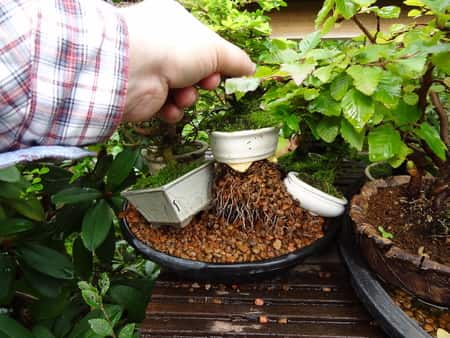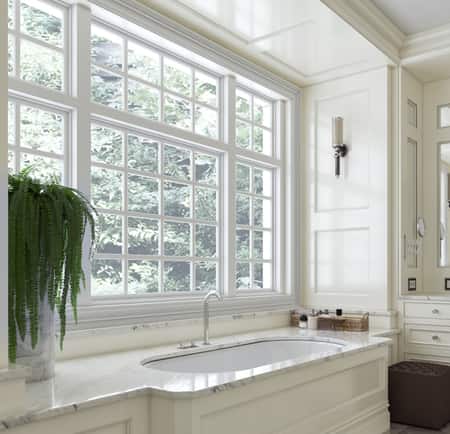Orchids thrive in humid climates, more than with we can provide inside our homes. For additional humidity, humidity trays have come up as a common solution. Some orchid growers say they are a perfect way to add humidity; others say it’s a waste of time.
How effective are orchid humidity trays? These trays will raise humidity 3 to 4 % around the base of your orchid. If your orchid pot is larger and taller, this percentage will fall to around 2%. This is a small amount compared to the fact that orchids thrive in 50 to 70% humidity.

The average inside humidity in a living room with an air conditioner or heater running is around 30%.
If you are depending on humidity trays to raise the levels to maintain an orchid, then it just won’t happen
…yet every little bit helps.Since orchid humidity trays are quite expensive for what they provide, (you can check out the cost here – Affiliate Link) I recommend making your own. I’ll show you below.
But before I do that, let’s look at how a humidity tray works.
How Do You Use A Humidity Tray?
An orchid humidity tray is easy to use. You need a shallow, cooking pan dish, that is at least one inch high. You might think that the deeper the dish is, the more water you can add, thus the more water will evaporate.
Evaporation is directly related to the surface area, not the depth. So, the wider and longer your dish is, the more evaporation it will provide. Some orchid growers use one extremely long dish and place several orchids on it, which is quite effective.
When you keep orchids grouped, they exchange and elevate the relative humidity around them. If they’re spread out in your home office, humidity is lost to the surrounding environment. These will need more humidity to keep healthy.
Also, deeper dishes require more pebbles, rocks, gravel, or filler content. Ice cube trays work well, too. Only if you want to make a fascinating floral design with the evaporation tray, it doesn’t have to be deep.
Whatever content for the tray or for the pebbles, make sure it isn’t water absorbing.
Here’s my take on humidity trays:
https://www.youtube.com/embed/7ABz93H4KlY Leca pebbles or clay pebbles, which are using in potting mix, are a common source but are NOT recommended.
These pebbles will soak up the humidity (like they do inside the potting medium) and quickly become mold-infested.

Fill the tray up with water to ¾ the height of the pebbles. Don’t fill the water over the pebbles, because then the pot sits in water. The potting medium will absorb the water around it causing root rot.
How Do Orchid Humidity Trays Work?
The idea of a humidity tray is based on osmosis: that elements move from a higher concentration to a lower concentration to maintain balance. If your living room is 30% humidity, and the orchid tray is 100%, then water will evaporate to better balance the two.
This works in theory.
The humidity that the tray will provide will only saturate the air to about two inches above the tray. Then the humidity is lost into the environment, dissipating as fast as it evaporated. If your pot is taller than 2 inches (which almost all are) then the humidity will not reach the underside of the leaves.
Aerial roots will still dry out. Anything on the upper side of your orchid pot will not receive any additional benefit from the humidity tray.
For this reason, if you are going to travel or can’t mist your orchids all the time, we suggest applying a thin topcoat of sphagnum moss around the top of the pot. By the way, we have a great article about caring for your orchids while on vacation here.
For the potting medium, the humidity provided by the tray will be sufficient, if your pot has holes. If you set a double-pot on top the humidity tray, you’re basically achieving nothing. To have better results, we suggest misting.
How Often Should Orchids Be Misted?
Misting is using a spray bottle and gently spritzing the orchid: leaves, roots, stem, everything but the blossom. Don’t spray too much. If water droplets start to run down the leaf then you’ve sprayed too much.Another concern with misting: always use the fan. If you mist an orchid and let the water sit, accumulating on top the leaves, gas exchange can’t occur. Suffocation causes cell death, creating black dots. Always have a fan running on low.
Humidity and air circulation go hand in hand.
You can read more about the relationship between those two in this article.

Mist in early morning, since they orchids will have time to dry out during the day. At night, humidity levels tend to be higher, so your orchid won’t need additional misting.
If your orchid is mounted, then you’ll need to mist a lot more, almost drenching the orchid. This will need to be done daily since mounted orchids dry out extremely fast.
Extra-large Orchid Pot: What Works for Humidity?
As we mentioned earlier, the humidity trays will raise levels of humidity up to two inches from the tray. After that, there is no real difference. For extra-large pots, I suggest a humidifier. This is the humidifier I use (Affiliate Link).

There are several brands on the market, including ultrasonic (which don’t produce a lot of noise) and evaporative (which are cheaper to acquire.) If you aren’t sure of what to look for in a humidifier, this post is a good place to start. It’s basically the aftermath of my research when I bought my humidifier. I searched hundreds of humidifiers, including ultrasonic, cool-mist, and evaporative and explained my reasoning behind my choice.
Does Humidity Fluctuate During Different Parts of the Day? Within Different Seasons?
Humidity is highest during the night, dropping down from the morning until late afternoon. This is why it’s important to mist or water your orchids first thing in the morning. Some genera of orchids like higher levels of humidity and need to be misted again around noon.

Image Credit: Orchideria 2021
During the summer, you’ll need to provide more humidity. The longer, hotter afternoons will naturally deprive the humidity in the air.
Our aim is to maintain a constant temperature, lighting, and humidity, adding only where one element is less or lacking.For example, in the winter, humidity lingers longer… So you’ll need to water and mist less. But you’ll need to provide brighter light.
Can I just place my orchid in the bathroom?
This is a common misconception about humidity. Yes, you can, but… In the bathroom there are large fluctuations of temperature. Most of the time, the environment is a steady temperature then all of the sudden it gets really hot and moist. Then, ten minutes later, the temperature and humidity are back to normal.
Lighting is the other reason that orchids should not be in the bathroom. Unless you keep you light on 12 to 14 hours a day, or are blessed to have a bathroom like the picture below, then there is insufficient light for the orchid to grow. Bathrooms tend to be darker rooms, having smaller windows.
The inconsistent, “Is it day?” then some minutes later, “Now it’s night?” every time someone turns on the bathroom light is confusing to the plant.
So, placing your orchid in the shower by the window sill in the bathroom is a horrible idea. Yet we have seen orchids places there by designers, interior decorators and in magazines. It’s easy to take a picture of an unsustainable condition, sell it, then have the home owner deal with the fact that their orchid is dying.


This for the orchid is extremely stressful.
In their natural environment, (tropical or subtropical rainforest) humidity and temperatures remain constant. The only temperature fluctuation is at night, dropping 15 degrees F (8 C).
Nevertheless, it’s the entire night that the temperature oscillates, not just ten minutes. If you’re adamant about bathroom orchids, in this post I wrote about orchids that could tolerate a bathroom.
What About Over the Kitchen Sink?
This is a little better than the bathroom, since kitchens tend to be lighter and brighter. But think about this scenario, related to humidity: you make spaghetti, and drain it in the sink. The hot steam raises directly above the sink and right into your orchid, steaming the leaves with burning humidity. Scalding temperatures and orchids don’t match.
Then you spend the entire week just washing dishes, and use nothing in terms of boiling water. The humidity levels fluctuate so much that the orchid has a hard time adjusting. If you’d like to keep the orchid in the kitchen.
Don’t install a planter directly over the sink, or in any radius where it will feel the consequences of your lunch preparations.
Don’t Stop Learning!
If you want to be included in more information and get a 14-page fertilization guide, please sign up for my newsletter. I don’t spam, but send emails out bi-monthly with some curious topics of interest. If you want more information, click here to go to a specific page on this website where I explain it more in detail.

Also, if you are looking for an orchid journal to keep your notes specifically about orchid care, check out my 2 solutions for that on this page. If note-keeping isn’t your thing, then there is a free excel spreadsheet that you can download. Click here for more information on how to do that.
If you subscribe to my newsletter, I will send you a 14-page guide on the main tips of orchid fertilizer. It is downloadable and you can print it out on your computer. I designed the guide to double up as a coloring book, just to make it fun.
How Do I Clean Humidity Trays?
The water in the trays should be filled daily, or when you notice that it’s lower than ¾ full. Since the potting medium will drain into the humidity tray, after a few months the pebbles will have chemical residue from fertilizer and whatever is in the water.
This is perfect for fungus and other microorganisms to grow.
Once every six months, a deeper cleansing will need to be done, by removing all the pebbles and washing them in the sink. This is to prevent bacteria build up, or aiding the possibility of mold. Rinse out the basin, too.
Now that you know all about humidity and how to make a simple humidity tray, it’s time to get your hands dirty. Check out some of our tutorials on how to design a great floral design or build a terrarium with orchids.
If this information was of any help or clarified any doubts you had, please mention so in the comments. I love to interact with other orchid enthusiasts, and we all can share from our experiences.
Happy cultivating!

